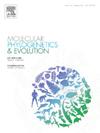非模式生物的物种形成连续体:重新审视地衣的物种对概念。
IF 3.6
1区 生物学
Q2 BIOCHEMISTRY & MOLECULAR BIOLOGY
引用次数: 0
摘要
进化生物学家长期以来一直在寻求理解种群流动、相互作用和进化的连续性,这最终会导致分化成不同的物种。地衣,通常被定义为复杂的生态系统,表现出非凡的进化机制,挑战了物种形成的传统定义。地衣中一个特别值得注意的现象是种对概念,在这种概念中,关系密切的分类群只是在繁殖策略上有所不同——一个是有性繁殖,另一个是无性繁殖。我们在标志性的胡须状地衣Usnea中研究了这一概念,通过比较三个物种对:U. aurantiacoatra/U. acoatra。南极洲,美国,佛罗里达/美国。佛罗里达南部和美国。perplexans。利用基于参考的RADseq数据和基于多变量和模型的基因组群体方法,我们评估了每对基因组的差异。我们的结果显示了分化的梯度:U. aurantiacoatra/U.;南极洲表现出强烈的谱系分离,没有基因组混合;美国媒介物/ U。困惑菌表现出适度分化,有基因流动的迹象;和U. florida/U. florida。亚佛罗里达形成了一个很大程度上无结构的分支,具有大量的基因组重叠。这些发现将这三对物种置于物种形成连续体的不同位置,并强调生殖模式是影响谱系分化的关键因素。我们的研究在一个连续体框架内重新构建了物种对的概念,并从一个非模型系统中提供了新的基因组见解,增强了我们对地衣形成真菌物种形成的理解。本文章由计算机程序翻译,如有差异,请以英文原文为准。

Speciation continuum in non-model organisms: Revisiting the species-pair concept in lichens
Evolutionary biologists have long pursued understanding the continuum in which populations flow, interact, and evolve, which can ultimately lead to divergence into distinct species. Lichens, which are often defined as intricate ecosystems, exhibit remarkable evolutionary mechanisms that challenge conventional definitions of speciation. A particularly notable phenomenon in lichens is the species-pair concept, in which closely related taxa only differ in their reproductive strategies − one reproducing sexually, the other asexually. We investigated this concept in the iconic beard-like lichen Usnea by comparing three species pairs: U. aurantiacoatra/U. antarctica, U. florida/U. subfloridana and U. intermedia/U. perplexans. Using reference-based RADseq data and applying multivariate and model-based genomic population methods, we evaluated genomic differentiation across each pair. Our results revealed a gradient of divergence: U. aurantiacoatra/U. antarctica showed strong lineage separation with no genomic admixture, U. intermedia/U. perplexans exhibited moderate differentiation with signs of gene flow, and U. florida/U. subfloridana formed a largely unstructured clade with substantial genomic overlap. These findings place the three species pairs at different positions along the speciation continuum and highlight reproductive mode as a key factor influencing lineage divergence. Our study reframes the species-pair concept within a continuum framework and provides new genomic insights from a non-model system, enhancing our understanding of speciation in lichen-forming fungi.
求助全文
通过发布文献求助,成功后即可免费获取论文全文。
去求助
来源期刊
CiteScore
7.50
自引率
7.30%
发文量
249
审稿时长
7.5 months
期刊介绍:
Molecular Phylogenetics and Evolution is dedicated to bringing Darwin''s dream within grasp - to "have fairly true genealogical trees of each great kingdom of Nature." The journal provides a forum for molecular studies that advance our understanding of phylogeny and evolution, further the development of phylogenetically more accurate taxonomic classifications, and ultimately bring a unified classification for all the ramifying lines of life. Phylogeographic studies will be considered for publication if they offer EXCEPTIONAL theoretical or empirical advances.

 求助内容:
求助内容: 应助结果提醒方式:
应助结果提醒方式:


